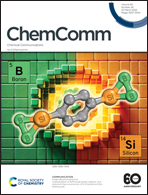Construction of a redox pathway through a polyoxometalate and covalent organic framework for H2O2 photosynthesis†
Abstract
A novel type of electron donor–acceptor system was built from a nitrogen-rich covalent organic framework (PC) and a polyoxometalate (BW12), fabricating a composite material (BW12@PC-250), which shows significantly improved photocatalytic H2O2 yield (56.4 μM h−1) under full spectrum illumination in pure water, being about 30 times higher than that of PC. This is due to the opening of the electron and proton transport pathway between PC and BW12, which paves a new way for POMs to modulate the photocatalytic reactions of COFs.



 Please wait while we load your content...
Please wait while we load your content...